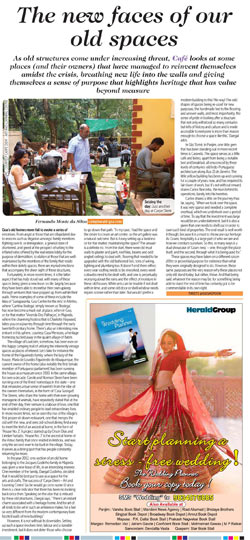
The new faces of our old spaces

Goa’s old homes never fail to evoke a series of emotion. From angst at those that are dilapidated due to reasons such as litigation amongst family members fighting over it, or immigration, a general state of disinterest, and greed at the prospect of selling to the inflated rates offered by the real estate lobby for the purpose of demolition, to elation at those that are well maintained by the members of the family that reside within their stately spaces, there are myriad emotions that accompany the sheer sight of these structures.
Fortunately, in more recent times, it is the latter aspect that has truly stood out, with many of these spaces being given a new lease on life, largely because they have been able to monetise their own upkeep through ventures that have popped up from within their walls. Prime examples of some of these include the likes of ‘Sunaparanta, Goa Centre for the Arts’ in Altinho, where ‘Cantina Bodega’, simply known as ‘Bodega’, has now become a must –eat-at place, when in Goa, or for that matter ‘Vivenda Dos Palhacos’, in Majorda, where the charming hostess that is Charlotte Hayward, takes you on a journey through time through the early twentieth century home. There’s also an interesting new entrant in this sphere, courtesy Casa Menezes, a heritage homestay trucked away in the quaint village of Batim.
The village of Loutolim, somehow, has been ever on this happy camping trail of utilising the inherently vintage spaces as places of interest. Let’s take for instance the house, Maria de Lourdes Figueiredo de Albuquerque, the current owner of the home (also notably the first female member of Portuguese parliament) has been running the house as a museum since 2010. In the same village, for over a decade, Carole and Norman Steen have been running one of the finest homestays in the state – one that emanates a true sense of warmth from the vibe of the owners themselves, in the form of ‘Casa Susegad’. The Steens, who share the home with their ever-growing menagerie of animals have repeatedly stated that at the end of their day, their venture is a labour of love, one that has enabled ordinary people to lead extraordinary lives. In more recent times, we’ve seen the rise of the village’s first proper sit – down restaurant, one that merges the old with the new, and sees old – school dining find a way to meet the feel of an ancestral home, in the form of ‘House No. 2’. A project started up by Orson Dias and Lineker Furtado, ‘House No. 2’ is the ancestral home of the Antao family that once resided in Ambora, and was only the second – ever to be built in the village. Today it serves as a dining spot that has people constantly returning for more.
In the year 2012, one section of an old home belonging to the Jacques Godinho, decided that it would be best put to use as a space for the arts and crafts. The success of ‘Carpe Diem – Art and Learning Centre’ (as he would go on to name it) since then is a clear indicator that there has been no looking back since then. Speaking on the vibe that is imbued by these old structures, Daegal says, “There’s an instant charm associated with a heritage home. And for a feel so very different from the modern contemporary bare faceted walls of new buildings”.
However, it is not without its downsides. Setting up such a space involves time, labour and a sizeable investment, but it does not deter those who choose to go down that path. “In my case I had the space and desire to create an art centre, so the art gallery was a natural outcome. But is it easy setting up a business or for that matter, maintaining the space? The answer is a definite no. From the start, there were old mud walls to plaster and paint, roof titles beams and odd angled ceilings to deal with, flooring that needed to be upgraded with the old fashioned feel, tons of wiring, lighting and plumbing too. It doesn’t end there either; every year roofing needs to be reworked, every week cobwebs need to be dealt with, and one is perpetually worrying about the rains and the effect of moisture in these old houses. White ants can be trouble if not dealt with in time, and some old door or shell window needs repairs sooner than later. But would I prefer a modern building to this? No way! The odd shapes being re-used for new purposes, the handmade feel to the flooring and uneven walls, and most importantly, the sense of pride in looking after a structure that not only withstood so many centuries but tells of history and culture and is made accessible to everyone is more than reason enough to choose a space like this”, Daegal adds.
N Sao Tome, in Panjim, one little gen that has been standing out in more recent times is Caravela. The space serves as a little café and bistro, apart from being a notable bed and breakfast, all ensconced by three levels of centuries –old Indo – Portuguese architecture along Rua 31 de Janeiro. The little yellow building has been up and running for a couple of years now, and has required its fair share of work, but it’s not without reward, shares Carlos Noronha, the man behind its operations, barely into his twenties.
Carlos shares a little on the journey thus far, saying, “When we took over the space, it was very sparse and need a complete overhaul, which we undertook over a period of time. To say that the investments was large would be an understatement, but it is also a given that one needs to shell out in order to own such kind of properties. The end result is well worth it though, because it is a must to showcase our heritage. As Goans, hospitality is a large part of who we are and how we conducr ourselves. So this, in many ways is a dual showcase of ‘Goan-ness’ – one, through the place itself, and the second, through what it is being used for”.
Thsese spaces may have taken on a different raison deter or proverbial purpose for existence than what they were originally designed to do. However, these same purpose are the very reason why these places not only still stand today, but rather, thrive. And that being able to stand the test of time has certainly got to be commendable in its own right.





